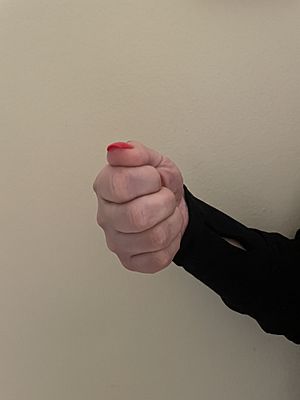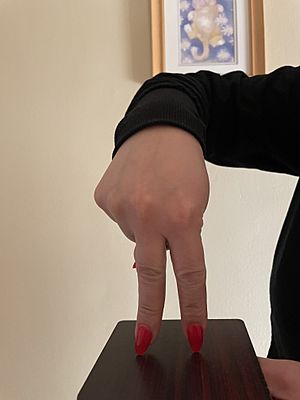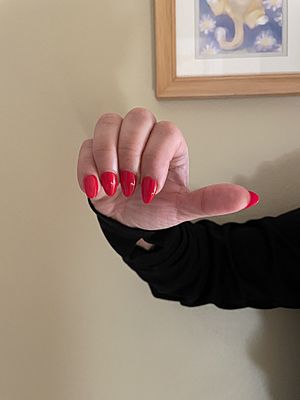Inuit Sign Language facts for kids
Quick facts for kids Inuit Sign Language |
||||
|---|---|---|---|---|
| ᐊᑦᒐᖕᒨᕐᖕᓂᖅ Atgangmuurngniq ᐆᒃᑐᕋᐅᓯᖏᑦ Uukturausingit Langue des Signes Inuk Inuk Tegnsprog |
||||
| Native to | Canada, possibly Greenland | |||
| Region | Nunavut | |||
| Ethnicity | Inuit | |||
| Native speakers | At least 47 Deaf in Nunavut (2000 (2000 data, 2014 pub.))e18 Unknown additional hearing speakers |
|||
| Language family | ||||
| Writing system | none | |||
| Official status | ||||
| Official language in | none | |||
| Recognised minority language in | Interpreted alongside ASL in the Legislative Assembly of Nunavut. | |||
|
||||
Inuit Sign Language (IUR) is a special sign language. It was created by Inuit people in the Canadian Arctic. This language is currently used in some communities in Nunavut. These include places like Baker Lake and Rankin Inlet. It might also be used in other Arctic areas where Inuit live. However, this has not been fully confirmed yet.
In 2000, about 155 deaf people lived in Nunavut. Around 47 of them used IUR. The others used American Sign Language (ASL) because of their schooling. We don't know how many hearing people use IUR. We also don't know how many people only use IUR.
IUR is a very rare language. It is also quite hidden. Because of this, the Canadian government does not officially protect it. But, since 2008, IUR is used in the Legislative Assembly of Nunavut. This means interpreters use it alongside ASL. People are now very interested in writing down and studying IUR. The Nunavut Council for People with Disabilities and the Inuit Broadcasting Corporation are helping with this. There is also a plan to teach IUR at Arctic College. This would help more people learn to interpret and translate the language.
Contents
Discovering Inuit Sign Language's Past
Since the 1700s, hearing Inuit used a type of sign language. They used it for trading and talking between different Inuit languages. This was similar to how Plains Indian Sign Language was used further south. Inuit Sign Language might have started when the Inuit lived a nomadic life. They may have created it to help with hunting.
Later, more deaf children were born in the area. The language was then used and changed to fit their needs. One of the first times this language was written about was in 1930. This might have been IUR or an older version of it. The Nunavut area has many people born deaf. For example, the number of people born deaf in Nunavut is six times higher than in southern Canada.
Deaf people are well-accepted in their communities. For every deaf person who uses IUR, there might be two hearing people who also know it well. This is like other communities with many deaf people, such as Martha's Vineyard. However, IUR is not (or no longer) used by hearing people to talk to each other. It is mainly used by deaf people and the hearing people they talk to regularly.
We don't know much about the full history of the language. Elders tell stories about IUR being used for many generations. Both hearing and deaf Inuit used it, especially when out on the land. But because communities are far apart, we don't fully understand who uses the language where. Still, IUR has been passed down in some families. This happens even if not everyone in the family is deaf. Being deaf in Inuit society is less of a problem than in other places. This helps IUR be more accepted and used.
Protecting Inuit Sign Language Today
Inuit Sign Language is a language that is in danger. Fewer people are using it. One main reason is that ASL is becoming more common. There are no official schools that teach in IUR. So, parents often send their deaf children to schools in southern Canada. In these schools, ASL is the main language. Sometimes, English is taught with ASL interpreters.
Because of this, there is no official alphabet for IUR. Only about one-third of the deaf population (47 people around 2000) use IUR as their first language. We don't know the status of the language outside of certain communities in Nunavut.
People are working to protect and write down the language. More and more people want to help local programs. They also want to document IUR. This became even more important after a court case in 1999. In that case, an Inuk man needed an interpreter, but none could be found.
The Nunavut Department of Culture, Language, Elders and Youth (CLEY) is helping. The Department of Justice is also involved. Dr. Jamie MacDougall is leading a project with community members. Their goal is to document and bring the language back to life.
Officially, Inuit Sign Language has no special rights or protections. It is not an official language in any province or territory. But, as mentioned, interpreters have used IUR in Nunavut's legislative assembly since 2008. They use it alongside ASL.
Different Ways of Signing IUR
Studying IUR is a new field. So, there is not much information about its different forms. However, we know that the language changes a bit across Nunavut. This is normal for language groups that are separated.
It is also said that a sign language in Greenland is similar to IUR. It might have words borrowed from ASL and Danish Sign Language. But we need more research to confirm this. We need to find out if Greenlandic Sign Language is a type of IUR or if it's more related to Danish Sign Language.
Beyond these differences, we don't know much about how far the language spreads. We also don't know if there are many different sign languages. It is believed that Inuit have used IUR, or a similar version, for many generations. This happened across much of their lands. But no current research confirms these stories. Because of this, IUR has not been found west of Nunavut.
Understanding IUR Grammar
Not many studies have been done on Inuit Sign Language grammar. One study in 2012 looked at how verbs agree and how classifiers are used. At this early stage, researchers cannot say the exact word order of the language. They plan to study how to show "no" and how words are built later.
So far, 33 different hand shapes have been identified. Also, early findings show that IUR does not use many non-manual signs at the same time. Non-manual signs are things like facial expressions. But it does use many manual signs at the same time. This means using both hands at once.
IUR also has limited verb agreement. But it has all types of verbs found in sign languages. These include plain verbs, agreement verbs, and spatial verbs. A "monomorphemic sign" is a sign with one main meaning. It usually has one main hand position and one movement. Finally, IUR does not seem to drop the subject of a sentence. Instead, it leaves the subject unclear. This fits well with Inuit culture.
How Words are Built
There are four ways to show that a noun is plural (more than one).
First, signs made near the body (body-anchored signs) look the same for one or many. You understand the meaning from the rest of the sentence. But for "arctic char" (a type of fish), you can repeat the sign to show many.
Second, complex signs in the middle signing area use circles, back-and-forth movements, or repetition to show plural.
Third, simple signs in the middle signing area are either two-handed or one-handed. Two-handed signs can be balanced or unbalanced. A balanced sign means both hands have the same position, shape, and movement. An unbalanced sign means one hand moves more than the other. Balanced signs don't change for plural. Unbalanced signs can be repeated to show plural.
Fourth, one-handed signs are known to use repetition for plural. But more studies are needed to fully understand this.
To say personal names, you sign the first letter of the name. You also mouth the name at the same time. The alphabet used for signing letters comes from ASL.
Verbs and Space in IUR
IUR uses three types of verbs: plain, agreement, and spatial. Plain verbs do not refer to an object or subject. For example, if you sign "CALL-ON-PHONE LONG-AGO" while thinking of Ottawa, the verb itself doesn't show Ottawa.
However, agreement verbs can change how they are done in different spaces. For example, if you sign "USE-ICE-AUGER" and then point to someone else and sign it again, the verb's location changes. This shows it agrees with the subject.
Agreement can also be seen with verbs that act on an object. For example, the verb "SEE" might only interact with its object. Verbs that agree with both the subject and the object are rare.
Finally, IUR also uses spatial verbs. These verbs use specific signing spaces. Some verbs create a space in front of the signer. Others use the index finger to point to a real place. This could be a nearby village or a city far away like Winnipeg. No matter how far, the signer will point in that direction.
But using spatial location is not always required. Sometimes, the location is known but not shown in the sign.
Pointing to Places
A special thing about IUR is how it points to real places. Like most sign languages, signers use the space in front of their body. This can mean "here" or refer to a person. But for real places, IUR points to those locations directly. This is done using the index finger or other hand shapes. The places can be local villages or cities thousands of kilometers away. The signer will always point or show the direction of that place.
Classifiers: Showing What Things Are Like
IUR uses "classifiers." These are signs that show how you handle an object or what kind of thing it is. Many other sign languages also use them.
"Handling classifiers" are used with verbs that act on an object. They show what the object is. For example, "PICK-UP:CLegg" means "pick up an egg." "MOVE:CLbox" means "move a box."
"Entity classifiers" show what kind of thing something is. So far, they have been found for vehicles, animals, two-legged beings, and flying birds. For example, "MOVE:CLbirds GOOSE SHOOT" means "geese flying in, I will shoot them." Handling classifiers are used more often.
|







